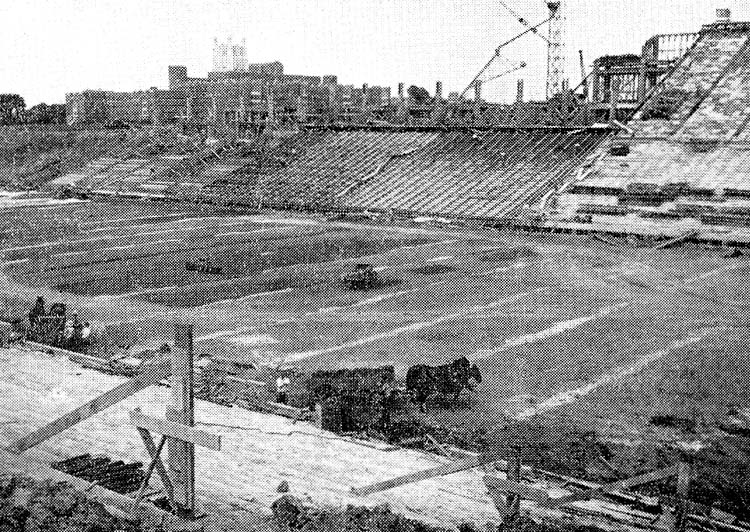
Horses provided the principal power during 1929 to dig out the bowl of the University of Iowa’s Kinnick Stadium
30 feet below surrounding ground level. The project was completed in just 199 days of working around the clock
six
days a week, costing less than $500,000. Many horses died.
|
By
Bob Hibbs Horse burials in Kinnick Stadium are the stuff of
legend with little basis in fact, according to oral history given the
author more than a quarter century ago by the late Magnus Christensen,
the “Great Dane” who headed the crew which dug the stadium during the
spring of 1929. The legend was reprinted about
10 days ago in the “states” news briefs in USA
Today. Kinnick was built in just 199 days from March 6
through Sept. 20, in 12-hour shifts until about July 1 when the pace
was slowed. Employment peaked at about 250 men. The stadium is a marvel, now seating 70,397. It
towers 80 feet above the playing field through 79 rows, rising 41 on a
gradual incline to the exit level, then 38 rows on a steeper incline to
the back wall, which is 50 feet above ground. The 30-foot below ground excavation was
accomplished with draft horses pulling an elongated steel bucket or
“slip” commanded by a teamster barking orders and slapping reins along
the horses’ backs. Some dirt was loaded into wagons, with most dumped
just north of the stadium, filling the head of a gully; some went as
far as the University of Iowa Art Building area. Christensen headed the teamsters. He later was a
member of the Masonic fraternity from the 1940s until his death July
24, 1980. Occasion of a conversation with the author was a local
fraternity dinner. Magnus was a Danish immigrant who worked
construction much of his life; then, during the 1950s was custodial
supervisor for Iowa City schools. Speaking good English with an accent, he responded
to “a brother” who at the time was a lodge officer and professional
property manager, not someone involved at that time with writing
articles on local historic subjects. The horses were huge, Christensen explained. A typical adult draft horse weighed about 2,000
pounds, standing just short of six feet at the withers (back at base of
neck). Pure-bred lines including Belgians,
Percherons and Clydesdales existed; but, most were mixed
breeds, or “work horses.” Generally, they pulled at a steady pace as long as
their teamster insisted; even to the point of exhaustion. Sometimes,
they worked double shifts after short breaks; that is, essentially
around the clock. Some were injured, some were just worked to death,
he said. They were stabled near where the 1934 Art Building now stands
across the river from the Iowa Memorial Union. It was an easy drive, Magnus explained, along a
long gully running southwest to the stadium, along the back (northwest)
face of the old law building, now International Center, between
University and Veterans Hospitals, then across the Hospital School
site. None of these buildings existed in 1929, except the original
section of U-Hospitals. Burying 2,000 pounds of horse beneath a structure,
or under a playing field, would have meant considerable work, and would
have left a huge hole as the carcass decayed. And, according to Christensen, that’s not what
happened. If they could walk, he said, they were walked to
the river, then shot. The carcass was dumped into the river. If they
couldn’t walk, they were shot on the work site and the carcass dragged
to the river. About a horse a week was lost; more some weeks. That’s the report Magnus Christensen gave over
dinner some 25 years ago. P.S. This article begins a sixth
year of providing a weekly piece in this series. It’s the 261st dating
from 1999. It’s fun doing it, stimulating and provides interesting
contact with readers. It’s an entirely volunteer effort; the author is
not paid other than receiving a complementary subscription. Next Saturday: Iowa City’s first federal
highway – in 1839. Bob Hibbs collects local postcards and other historic ephemera and researches history related to them.
|